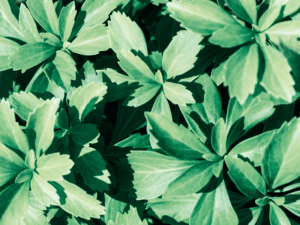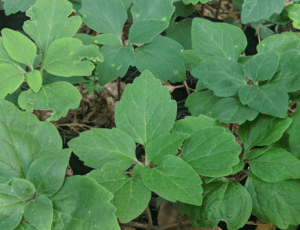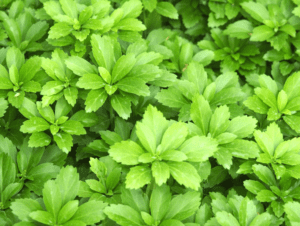
Want a gorgeous, low-effort landscape? Pachysandra is your answer. This shade-loving superstar spreads quickly, suppresses weeds, and offers year-round greenery with minimal fuss.
What is Pachysandra?
Pachysandra, a Japanese spurge, is a beloved evergreen ground cover. It’s prized for its lush, dark green foliage, low maintenance needs, and ability to thrive in shady areas where grass struggles. Native to Japan, Pachysandra is hardy in USDA zones 4-8. It spreads through underground stems, forming a dense carpet that suppresses weeds and adds beautiful texture to your landscape.
Pachysandra Varieties
Japanese Pachysandra (Pachysandra terminalis): The Versatile Ground Cover

Japanese Pachysandra is the most widely used variety of this beloved ground cover, and for good reason. Here’s a closer look at its characteristics and benefits:
-
Appearance: Japanese Pachysandra features glossy, dark green leaves with a leathery texture. These leaves are arranged in whorls along the stems, creating a dense, lush appearance.
-
Growth Habit: This variety spreads vigorously through underground stems (rhizomes), forming a thick carpet that can easily fill in shady areas. It typically reaches a height of 6-12 inches.
-
Flowers: In early spring, Japanese Pachysandra produces small, white, fragrant flowers on upright spikes. While not particularly showy, they add a delicate touch and a pleasant scent.
-
Hardiness: Japanese Pachysandra is hardy in USDA zones 4-8, tolerating a range of climates.
-
Versatility: This ground cover excels in a variety of landscape settings:
- Shade gardens: Thrives under trees and shrubs where grass struggles.
- Slopes and hillsides: Helps with erosion control due to its dense root system.
- Walkway borders: Creates a neat, defined edge.
- Mass plantings: Forms a lush, green carpet for large areas.
Cultivars: Several cultivars of Japanese Pachysandra are available, offering variations in leaf size, variegation, and growth habit:
- ‘Green Carpet’: A popular choice with smaller leaves and a more compact form.
- ‘Silver Edge’: Features leaves edged in white, adding visual interest.
- ‘Green Sheen’: Boasts extra-glossy leaves.
Tips for Growing Japanese Pachysandra
- Follow the general planting and care guidelines outlined in the article.
- Japanese Pachysandra can be somewhat invasive in ideal conditions. If you want to restrict its spread, consider using edging or barriers.
-
Allegheny Spurge (Pachysandra procumbens): A Native North American Beauty

Allegheny Spurge is a beautiful choice for gardeners seeking a native ground cover with a unique touch. Here’s what sets it apart:
-
Appearance: The primary distinguishing feature of Allegheny Spurge is its foliage. The leaves are a softer shade of green than Japanese Pachysandra and boast beautiful mottling with silvery-gray and purplish markings. They have a slightly more delicate texture than their Japanese cousins’ leathery leaves.
-
Growth Habit: Allegheny Spurge spreads through rhizomes like Japanese Pachysandra but has a slightly looser and more open growth habit. It also grows a bit taller, reaching 8-12 inches.
-
Flowers: Like Japanese Pachysandra, Allegheny Spurge produces small white flowers on spikes in early spring. The flowers are also fragrant, adding a subtle sweetness to the air.
-
Hardiness: Allegheny Spurge is hardy in USDA zones 5-9, making it slightly more adaptable to warmer climates than Japanese Pachysandra.
-
Nativity: Allegheny Spurge is native to the southeastern United States, making it an environmentally conscious choice for gardeners in that region.
Reasons to Choose Allegheny Spurge
- Unique Foliage: The mottled leaves offer visual interest and a softer look compared to Japanese Pachysandra.
- Native Plant: Supports local ecosystems and biodiversity.
- Less Aggressive: Allegheny spurge spreads slightly slower than Japanese Pachysandra, making it easier to manage in smaller areas or where you want a less dense ground cover.
Tips for Growing Allegheny Spurge
- As with other Pachysandra varieties, provide shade or partial shade and well-draining soil.
- It may take longer to establish than Japanese Pachysandra, so patience is key.
If you’re looking for a beautiful groundcover with a touch of native charm, Allegheny Spurge is a fantastic option!
‘Green Carpet’ Pachysandra: The Perfect Miniature Groundcover

‘Green Carpet’ is a popular cultivar of Japanese Pachysandra specifically selected for its compact size and tidy appearance. Here’s what makes it stand out:
-
Size: As its name suggests, ‘Green Carpet’ stays closer to the ground, typically reaching a height of only 4-6 inches. This makes it an excellent choice for smaller spaces or where a low-growing groundcover is desired.
-
Foliage: The leaves of ‘Green Carpet’ are smaller and more densely packed than standard Japanese Pachysandra. They retain the classic glossy, dark green color.
-
Growth Habit: ‘Green Carpet’ still spreads via underground rhizomes, but its growth is more controlled. It forms a dense, carpet-like mat without being as aggressive as some Pachysandra varieties.
-
Uses: ‘Green Carpet’ excels in many of the same landscape situations as traditional Japanese Pachysandra:
- Under trees and shrubs
- As a border or edging plant
- In rock gardens or between stepping stones
- Smaller-scale mass plantings
Benefits of Choosing ‘Green Carpet’
- Tidy Appearance: Its compact size and dense foliage create a neat and manicured look.
- Versatility: Works beautifully in both small and large spaces due to its contained growth.
- Low Maintenance: Requires the same general care as other Pachysandra varieties, making it an easy addition to your landscape.
Tips for Growing ‘Green Carpet’
- Follow the standard planting and care recommendations for Japanese Pachysandra.
- Since it’s less vigorous than some varieties, consider planting cuttings slightly closer together (4-8 inches apart) to achieve a quicker fill-in.
If you love the look of Japanese Pachysandra but want a more restrained and refined version, ‘Green Carpet’ is a fantastic choice!
‘Silver Edge’ Pachysandra: Adding a Splash of Brightness

‘Silver Edge’ is a delightful Japanese Pachysandra cultivar that adds light and vibrancy to shady garden spaces. Its defining characteristic:
-
Variegation: The leaves of ‘Silver Edge’ boast a bright white margin, creating a beautiful contrast against the dark green center. This variegation offers visual interest and brightens up areas that might otherwise feel too dark.
-
Growth Habit: Similar to standard Japanese Pachysandra, ‘Silver Edge’ spreads through rhizomes and forms a dense ground cover. However, it is known to be slightly slower-growing than non-variegated varieties.
-
Flowers: Like other Pachysandra, ‘Silver Edge’ produces small, fragrant white flowers in early spring.
-
Uses: ‘Silver Edge’ is beneficial for:
- Adding contrast and brightening shady areas.
- Creating eye-catching borders along paths or walkways.
- Pairing with other shade-loving plants that have darker foliage.
- Adding interest to rock gardens or underplanting shrubs.
Reasons to Choose ‘Silver Edge’
- Visual Appeal: The striking variegation sets this Pachysandra apart and creates a beautiful focal point.
- Shade Tolerance: Thrives in areas where other variegated plants may struggle due to insufficient sunlight.
- Easy Care: Requires the same low-maintenance care as other Pachysandra varieties.
Tips for Growing ‘Silver Edge’
- Provide shade or partial shade and well-draining soil as with other Pachysandra.
- Since it may grow more slowly, consider planting cuttings closer together (4-8 inches apart).
- The white variegation may revert to solid green occasionally. Prune out these reverted stems to maintain the desired appearance.
If you want a groundcover that stands out in the shade, ‘Silver Edge’ Pachysandra is a stunning choice!
Pachysandra Planting Tips
-
Location: Pachysandra thrives in full shade or partial shade. Avoid planting in areas with prolonged direct sunlight, especially during hot afternoons, as the intense sun can scorch the leaves and lead to browning. Ideal locations include under trees, alongside buildings, or on the north side of structures.
-
Soil: While Pachysandra is adaptable to various soil types, it flourishes in a slightly acidic (pH 5.5 – 6.5), moist, and well-draining soil. If your soil is heavy clay, amend it with organic matter like compost or leaf mold to improve drainage and texture. For very sandy soils, adding organic matter also helps with moisture retention.
-
Spacing: Plant Pachysandra cuttings 6-12 inches apart. This spacing allows for adequate room as the plants spread and fill in the area. Closer spacing will result in quicker coverage, while wider spacing means a longer wait for a full groundcover effect.
-
Planting Time: The best times to plant Pachysandra are in early spring or early fall. This gives the plants time to establish their root systems before the extreme temperatures of summer or winter set in.
-
Planting Process:
- Dig holes approximately 4-5 inches deep and 6 inches in diameter.
- Gently place a Pachysandra cutting in each hole, ensuring the roots are in contact with the soil.
- Backfill the holes with soil, gently tamping it down around the base of the plant.
- Water the newly planted Pachysandra thoroughly and deeply to settle the soil and encourage root growth.
Caring for Your Pachysandra Ground Cover
- Watering: Water regularly until established. Once established, Pachysandra is somewhat drought-tolerant, but deep watering during dry spells is beneficial.
- Fertilizing: Apply a balanced, slow-release fertilizer once a year in spring.
- Pruning: Prune in early spring before new growth begins to control size and shape. You can also lightly shear the tips to encourage bushier growth.
- Mulching: A layer of mulch helps retain moisture, suppress weeds, and add nutrients as it decomposes.
Common Pachysandra Problems & Solutions
- Volutella Blight: This fungal disease causes brown spots and stem dieback. Treat with a fungicide and remove infected plant parts.
- Scale Insects: These small pests can be controlled with insecticidal soap.
- Winter Burn: In colder climates, Pachysandra foliage may turn brown in winter. This usually recovers in spring.
Using Pachysandra in Your Landscape
- Under Trees and Shrubs: Pachysandra excels in the shade of larger plants.
- Erosion Control: Its dense root system helps stabilize slopes.
- Borders and Edging: Creates a tidy, defined edge along paths and flower beds.
- Foundation Plantings: Softens the look of building foundations.
Additional Tips
- Propagation: Pachysandra is easily propagated by division or cuttings.
- Patience: Pachysandra may take a few seasons to establish and spread fully.
Conclusion
Pachysandra offers more than just practical benefits; it transforms shady spaces into tranquil havens. From the vibrant green of Japanese Pachysandra to the delicate variegation of ‘Silver Edge’, this ground cover adds year-round visual interest to your landscape. It’s a beautiful and resilient solution for bringing life and texture to even the most underutilized areas.

























